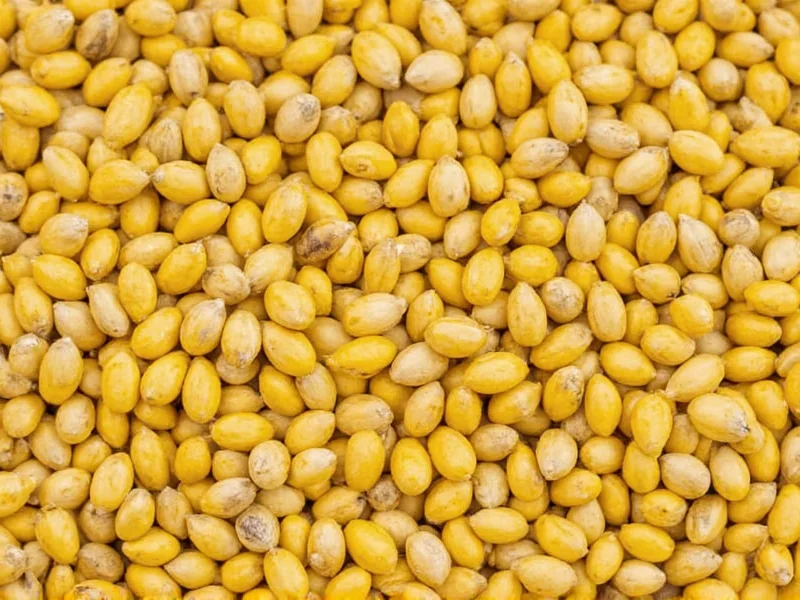Understanding the taste of mustard seeds requires examining different varieties and preparation methods. These tiny powerhouses transform dramatically based on how you use them in cooking. The flavor journey begins with raw seeds but evolves through toasting, grinding, and liquid activation.
Three Main Types of Mustard Seeds and Their Flavor Profiles
Not all mustard seeds taste the same. The three primary varieties—yellow, brown, and black—each offer distinct flavor characteristics that impact your dishes differently. Knowing these differences helps you select the right seed for your culinary creations.
| Seed Type | Raw Taste Profile | Activated Heat Level | Common Culinary Uses |
|---|---|---|---|
| Yellow (White) Mustard Seeds | Mild, slightly bitter, nutty | Low to moderate | American yellow mustard, pickling, salad dressings |
| Brown Mustard Seeds | Earthy, pungent, moderately spicy | Moderate to high | Dijon mustard, Indian curries, sauerkraut |
| Black Mustard Seeds | Strongly pungent, intensely spicy | High | Traditional Indian cooking, Ethiopian stews |
The Science Behind Mustard's Signature Heat
What do mustard seeds taste like when raw versus prepared? This question reveals mustard's fascinating biochemical transformation. Raw seeds contain sinigrin (a glucosinolate) and myrosinase (an enzyme), kept separate within the seed structure. When you crush or chew the seeds, these compounds mix with moisture, triggering a reaction that produces pungent isothiocyanates—the compounds responsible for mustard's characteristic heat.
The type of liquid used affects the final flavor. Acidic liquids like vinegar create a sharper, more immediate heat, while cold water produces a milder, longer-lasting warmth. This explains why prepared mustard tastes completely different from whole seeds. Many home cooks wonder why their mustard seeds don't taste spicy until processed—a perfect example of how preparation method transforms mustard seed flavor profile in cooking.
How Cooking Techniques Alter Mustard Seed Flavor
Dry-toasting mustard seeds in a pan before use significantly changes their taste profile. The Maillard reaction develops rich, nutty notes while mellowing the raw bitterness. Properly toasted seeds emit a fragrant aroma and turn slightly darker—over-toasting creates unpleasant burnt flavors.
Tempering (tadka) in Indian cooking involves adding mustard seeds to hot oil, where they pop and release flavors into the cooking medium. This technique distributes the mustard seed taste throughout the dish without making individual seeds prominent. Understanding how toasting changes mustard seed flavor helps prevent bitterness while maximizing aromatic compounds.
When making homemade mustard, the grinding process and resting time dramatically impact heat development. Freshly ground mustard reaches peak pungency after 10-15 minutes as the enzymatic reaction completes. This explains what do raw mustard seeds taste like versus fully activated prepared mustard.
Culinary Applications Based on Flavor Characteristics
Yellow mustard seeds work best in applications requiring mild background flavor without overwhelming heat. Their subtle taste makes them ideal for American-style yellow mustard and pickling solutions where vinegar dominates.
Brown mustard seeds strike the perfect balance for most prepared mustards. Their moderate heat develops beautifully when mixed with wine or verjuice, creating the complex flavor profile found in Dijon and whole-grain mustards. This variety answers the common question about difference between yellow and brown mustard seeds taste in practical cooking terms.
Black mustard seeds deliver intense heat favored in traditional South Indian and Ethiopian cuisines. Their robust flavor stands up to long cooking times in curries and stews. Many chefs blend black and yellow seeds to achieve layered heat—starting intense then mellowing during cooking.
Storing Mustard Seeds to Preserve Flavor
Mustard seeds gradually lose potency over time. For optimal taste, store them in airtight containers away from light and heat. Whole seeds maintain freshness for 2-3 years, while pre-ground mustard powder lasts only 6-12 months. Freezing extends shelf life significantly. Proper storage ensures you experience the true mustard seed flavor profile without stale or rancid notes.
FAQ: Mustard Seed Taste Questions Answered
Why don't raw mustard seeds taste spicy?
Raw mustard seeds don't taste spicy because the heat-producing compounds remain separated within the seed structure. The pungent allyl isothiocyanate only forms when seeds are crushed and mixed with liquid, allowing the enzyme myrosinase to react with sinigrin. This biochemical process takes several minutes to reach full intensity.
What makes black mustard seeds hotter than yellow varieties?
Black mustard seeds contain higher concentrations of sinigrin and more active myrosinase enzyme than yellow seeds. This creates more pungent isothiocyanate compounds when activated. Black seeds also have thinner seed coats that allow faster enzymatic reactions, resulting in quicker, more intense heat development.
How does vinegar affect mustard seed heat?
Vinegar lowers the pH, which initially accelerates the heat-producing reaction but then denatures the myrosinase enzyme, stopping further heat development. This creates an immediate sharp heat that mellowing over time. Mustards made with vinegar have brighter, more assertive initial heat compared to those made with water, which develop gradually increasing pungency.
Can you eat mustard seeds raw?
Yes, you can safely eat mustard seeds raw, though their hard texture and bitter taste make them unpleasant to consume this way. Raw seeds provide minimal nutritional benefit compared to prepared forms. The compounds become more bioavailable and palatable after grinding and liquid activation. Some traditional cuisines use raw seeds in small quantities for texture contrast in breads and crackers.
Why does homemade mustard get milder over time?
Homemade mustard gradually mellowing occurs because the heat-producing compounds (isothiocyanates) break down over time, especially when exposed to air. Acidic ingredients like vinegar accelerate this degradation. Properly sealed and refrigerated mustard maintains peak heat for 2-3 weeks before noticeably mellowing. This explains why freshly prepared mustard has more intense heat than store-bought varieties.











 浙公网安备
33010002000092号
浙公网安备
33010002000092号 浙B2-20120091-4
浙B2-20120091-4